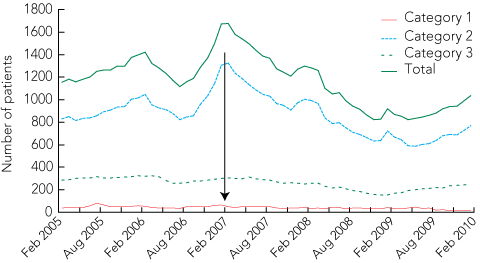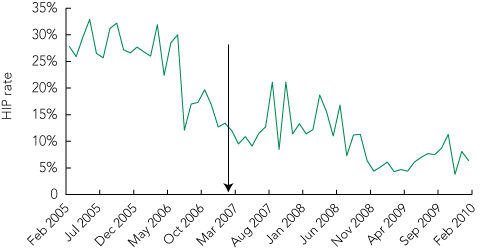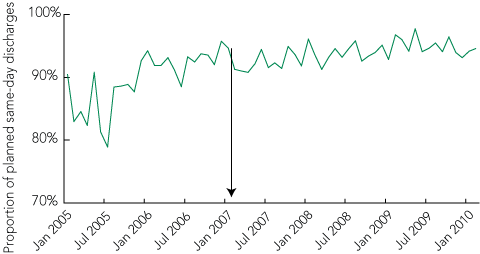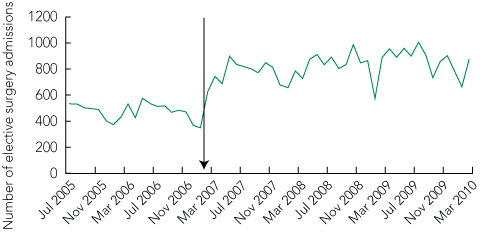Increasing demand for acute hospital care in the past 20 years has led to problems accessing care and longer waiting times for patients needing emergency or elective surgery.1 Unplanned emergency surgery competes with scheduled elective surgery, and, when resources are limited, elective procedures are cancelled,2 which disrupts patient flow and may compromise patient safety.3
The Alfred is a major tertiary, 638-bed hospital in Melbourne, a state capital in south-eastern Australia (population, 3.9 million in 2008).4 It is Australasia’s largest designated trauma service,5 and provides elective surgery for the state of Victoria.6 By the end of 2005, with the increase in demand, prioritisation of time-critical emergency surgery was having an increasing impact on elective surgery waiting lists, with hospital-initiated postponement (HIP) rates reaching almost 30%.
With a focus on the patient journey from initial referral to discharge, the redesigned surgical care model was streamlined, standardised, and protocol-led (Box 1). It incorporated patient screening and allocation to an appropriate ward by the perioperative coordinator; one-day attendance at a pre-admission clinic for pre-surgical evaluation and investigations; and coordination of individually tailored discharge support before admission. The redesigned processes became part of standard operating practices for all elective surgery patients and facilitated the development of admission and activity targets.
summaries of all elective surgery procedures performed;
numbers of patients having planned day surgery who were discharged on the day of admission;
numbers of elective surgery patients waiting longer than nationally recommended maximum waiting times (including patients ready and not ready for care); and
HIP rates (number of patients whose elective procedure was postponed by the hospital as a percentage of the number of planned elective surgery procedures).
Analyses of changes in LOS before and after the redesign were performed with Stata 11 (Stata Statistical Software, release 11, StataCorp, College Station, Tex, USA) using the Wilcoxon rank-sum test, a non-parametric test for non-normally distributed data.7 A P value of 0.05 was considered significant.
As shown in Box 2, after the new model of care was implemented and the Alfred Centre was opened, there was a sustained downward trend in the combined numbers of patients waiting longer than recommended for their elective surgery, in both the main Alfred Hospital and the Alfred Centre.8 Comparing data from February 2010 with February 2005, there was a 45% decrease in the numbers of Category 2 patients (semi-urgent) waiting longer for surgery than the recommended time of < 90 days.
The combined HIP rate for planned elective admissions in the main Alfred Hospital and the Alfred Centre decreased over the period February 2005 to February 2010 from 28% to 6% as shown in Box 3. By February 2011, HIP rates at the Alfred Centre and the main Alfred Hospital were less than 1% and 7%, respectively.
Box 4 shows the combined LOS for 2010’s top 10 surgical DRGs and individual LOS for 2010’s top six surgical DRGs, before and after introducing the new model of care, for both the Alfred Centre and the main Alfred Hospital. There was a reduction in combined LOS for the top surgical DRGs from a mean of 4.8 days before the redesign to a mean of 2.3 days after the redesign, and the mean LOS also decreased for patients having lens or hernia procedures, and for those having laparoscopic cholecystectomy (Box 4). The differences in combined LOS and the DRG-specific LOS between the two time periods were significant (P < 0.001; Wilcoxon Mann–Whitney test for non-normally distributed data), as were the LOS differences for anal and stomal procedures and transurethral procedures (P < 0.001).
The overall proportion of patients discharged on the day of admission and procedure increased after implementing the process redesign, with a continuing overall upward trend in successful same-day discharges. There was a rise in the proportion of successful same-day discharges from 83% in February 2005 to 95% in February 2010 (Box 5).
The number of patients admitted to the Alfred Hospital per month for elective surgery increased after the opening of the Alfred Centre in February 2007. In the quarter ending 30 September 2009, there were 2648 elective surgery admissions compared with 1560 for the same quarter 4 years previously. This represented an increase of 70%. Box 6 shows the change over time in elective surgery admissions per quarter.
This is an important result for the Alfred’s emergency and trauma services, which like other emergency departments have sustained year-on-year increases in demand.9 These positive gains were shared by patients, the wider community and the whole hospital, with reduced LOS, improved patent flow, patient-centred care, minimal disruption to daily living for those having same-day care, reduced waiting times, and reduced risk of cancellation of surgery.
Reductions in DRG-specific and combined LOS are also important for coping with increasing demand. Benchmarking against the Health Roundtable data10 showed that the combined and DRG-specific LOS were similar to or lower than those at comparable hospitals around Australia. There is clear evidence from the data on specific DRGs that the redesign and streamlining of processes have improved efficiency. The substantial rise in the number of patients discharged on the same day as their admission and procedure reflects the successful streamlining of processes. Although we have not addressed cost savings, a previously published pilot redesign project in a Sydney hospital was accompanied by a reduction in costs.11
Comparable clinical process redesigns in hospitals in Sydney and Scotland1,11-13 have resulted in similar reductions in waiting times and cancellation rates. The process redesigns in Sydney, which also involved coordination and streamlining of patients through a pre-admission clinic using protocol-based processes, demonstrated reduced LOS, shorter operating times, theatre cost savings, and reduced waiting lists.11
The strength of our study is the comparison of outcomes before and after the introduction of a redesigned model of care in a major metropolitan teaching hospital. To our knowledge, the only other study comparing LOS before and after a redesigned model of care was the small pilot study mentioned earlier.11
2 Number of patients waiting longer than nationally recommended waiting times for elective surgery, Alfred Hospital and Alfred Centre, Feb 2005 – Feb 2010

Arrow denotes when the Alfred Centre was opened (Feb 2007).
Category 1 = Urgent < 30 days; Category 2 = Semi-urgent < 90 days;
Category 3 = Non-urgent < 365 days.
3 Changes in hospital-initiated postponement (HIP) rates,* Alfred Hospital and Alfred Centre, Feb 2005 – Feb 2010

4 Lengths of stay (LOS) for 2010’s top surgical diagnostic-related groups, before (Feb 2005 – Feb 2006) and after (Feb 2009 – Feb 2010) the process redesign
Diagnostic-related group (DRG) |
Main Alfred Hospital (Feb 2005 – Feb 2006) |
Main Alfred Hospital and Alfred Centre (Feb 2009 – Feb 2010) |
|||||||||||||
Laparoscopic cholecystectomy w/o closed CDE or w/o Cat/Sev CC |
|||||||||||||||
|
|
|||||||||||||||
Provenance: Not commissioned; externally peer reviewed.
Received 20 September 2010, accepted 14 March 2011
- Judy A Lowthian1
- Andrea J Curtis1
- Bernadette L Comitti2
- Peter A Cameron1
- Martin J Keogh2
- William R Johnson2
- James Tomlinson2
- Andrew M Stripp2
- 1 Department of Epidemiology and Preventive Medicine, School of Public Health and Preventive Medicine, Centre of Research Excellence in Patient Safety, Monash University Melbourne, VIC.
- 2 Alfred Health, Melbourne, VIC.
We thank Jane Smart for help with data extraction.
None identified.
- 1. MacLellan DG, Cregan PC, McCaughan BC, et al. Applying clinical process redesign methods to planned arrivals in New South Wales hospitals. Med J Aust 2008; 188 (6 Suppl): S23-S26. <MJA full text>
- 2. Nasr A, Reichardt K, Fitzgerald K, et al. Impact of emergency admissions on elective surgical workload. Ir J Med Sci 2004; 173: 133-135.
- 3. O’Connell TJ, Ben-Tovim DI, McCaughan BC, et al. Health services under seige: the case for clinical process redesign. Med J Aust 2008; 188 (6 Suppl): S9-S13. <MJA full text>
- 4. Australian Bureau of Statistics. Population by age and sex, regions of Australia, 2008. Canberra: ABS, 2009. (ABS Cat No. 3235.0.)
- 5. Victorian Government Department of Human Services. Victorian State Trauma Registry 2007 – 2008. Victorian State Trauma Outcome Registry and Monitoring Group, Monash University. Melbourne: DHS, 2009. http://www.health.vic.gov.au/trauma/publications/0708vstorm-sumrep.pdf (accessed Apr 2011).
- 6. Alfred Health. Quality of care report, 2008. http://www.alfred.org.au/Assets/Files/AH_Quality OfCare2008.pdf (accessed Apr 2011).
- 7. Qualls M, Pallin DJ, Schuur JD. Parametric versus nonparametric statistical tests: the length of stay example. Acad Emerg Med 2010; 17: 1113-1121.
- 8. Victorian Government Department of Human Services. Elective surgery access policy. Melbourne: DHS, 2009. http://www.health.vic.gov.au/surgery/pubs/elective_surgery_access_policy_2009.pdf (accessed Apr 2011).
- 9. Lowthian JA, Curtis AJ, Cameron PA, et al. Systematic review of trends in emergency department attendances: an Australian perspective. Emerg Med J 2010; Oct 20. Epub ahead of print. doi:10.1136/emj.2010.099226.
- 10. The Health Roundtable. Promoting innovation in health care. http://www.healthroundtable.org/ (accessed [members only] Apr 2011).
- 11. Singh N, Brooke-Cowden GL, Whitehurst C, et al. The Auburn Elective Surgery Pilot Project. ANZ J Surg 2005; 75: 768-775.
- 12. Addison PD, Getgood A, Paterson-Brown S. Separating elective and emergency surgical care (the emergency team). Scott Med J 2001; 46: 48-50.
- 13. Tey A, Grant B, Harbison D, et al. Redesign and modernisation of an NHS cataract service (Fife 1997–2004): multifaceted approach. BMJ 2007; 334: 148-152.








Abstract
Objective: To evaluate the effectiveness of redesigning and streamlining perioperative services.
Design: A before-and-after evaluation, with retrospective analysis of de-identified administrative data.
Setting: A major tertiary hospital, Melbourne, Australia.
Participants: Patients undergoing elective surgery, February 2005 – February 2010.
Intervention: Implementing a process redesign to streamline clinical pathways for elective surgery, with a focus on the patient journey from referral to discharge, and establishing a separate, dedicated elective surgery facility.
Main outcome measures: Numbers of patients waiting beyond national recommended waiting times for elective surgery; hospital-initiated postponement (HIP) rates for elective surgery; and lengths of stay (LOS), both combined and for specific diagnostic-related groups.
Results: The clinical process redesign resulted in a sustained downward trend in the number of elective surgery patients waiting longer than national recommended maximum waiting times. HIP rates were reduced to 1% in the dedicated elective surgery facility, and there was a significant reduction in the combined LOS, as well as the LOS for the most common surgical procedures (P < 0.001).
Conclusions: Clinical process redesign of perioperative services and collocation of a separate elective surgery centre improved (i) timeliness of care for elective surgery patients and (ii) key indicators (LOS and HIP rates) for planned elective admissions.